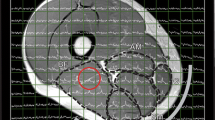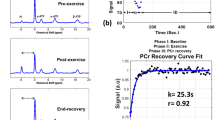Abstract
A Turkish couple suffering from McArdle disease (myophosphorylase deficiency) and their two sons aged 5 and 9 years, respectively, were studied using31phosphorus magnetic resonance spectroscopy (31P MRS). During exercise both sons showed the same pathological pattern as their parents. In contrast to healthy volunteers, intracellular pH (pHi) as measured by31P MRS every 10s during exercise, never fell below the lower 95% confidence limit (6.94) of pHi at rest (7.06), but tended to be raised. It is of special interest that the 5-year-old boy was completely asymptomatic, although the enzyme defect seems to be fully expressed at the cellular level.
Similar content being viewed by others
Abbreviations
- ADP:
-
adenosine diphosphate
- ATP:
-
adenosine triphosphate
- Mg:
-
magnesium
- Pi :
-
inorganic phosphate
- Ptot :
-
Sum of peak areas (PME+Pi+PCr+γATP+αATP+βATP)
- PCr:
-
phosphocreatine
- pHi :
-
intracellular pH
- PME:
-
phosphomonoesters
- 31PMRS:
-
31 phosphorus magnetic resonance spectroscopy
References
Argov Z, Bank WJ, Maris J, Chance B (1987) Muscle energy metabolism in McArdle's syndrome by in vivo phosphorus magnetic resonance spectroscopy. Neurology 37:1720–1724
Boesch C, Martin E (1988) Combined application of MR imaging and spectroscopy in neonates and children: installation and operation of a 2.35-T system in a clinical setting. Radiology 168:481–488
Bogusky RT, Taylor RG, Anderson LJ, Angelos KL, Liebermann JS, Walsh DA (1986) McArdle's disease heterozygotes. Metabolic adaptation assessed using 31-P-nuclear magnetic resonance. J Clin Invest 77:1881–1887
Burt CT, Koutcher J, Roberts JT, London RE, Chance B (1986) Magnetic resonance spectroscopy of the musculoskeletal system. Radiol Clin North Am 24:321–331
Duboc D, Jehenson P, Tran Dinh S, Marsac C, Syrota A, Fardeau M (1987) Phosphorus NMR spectroscopy study of muscular enzyme deficiency involving glycogenolysis and glycolysis. Neurology 37:663–671
Frick E, Reutter FW, Weder B (1988) McArdle Krankheit: eine Differentialdiagnose des belastungsbedingten Creatinkinaseanstiegs. Schweiz Med Wochenschr 118:1993–1996
Haller RG, Lewis SF, Gunder M, Dennis M (1985) Ammonia production during exercise in McArdle syndrome — an index of muscle energy supply and demand. Neurology 35:207
Howell RR, Williams JC (1983) The glycogen storage diseases. In: Stanbury JB, Wyngaarden JB, Fredrickson DS, Goldstein JL, Brown MS (eds) The metabolic basis of inherited disease. McGraw-Hill, New York, pp 157–159
Kono N, Mineo I, Sumi S, Shimizu T, Kang J, Nonaka K, Tarui S (1984) Metabolic basis of improved exercise tolerance: muscle phosphorylase deficiency after glucagon administration. Neurology 34:1471–1476
Lewis SF, Haller RG (1986) The pathophysiology of McArdle's disease: clues to regulation in exercise and fatigue. J Appl Physiol 61:391–401
Petroff OAC, Prichard JW, Behar KL, Alger JR, Hollander JA den, Shulman RG (1985) Cerebral intracellular pH by 31P nuclear magnetic resonance spectroscopy. Neurology 35:781–788
Ross BD, Radda GK, Gadian DG, Rocker G, Esiri M, Falconer-Smith J (1981) Examination of a case of suspected McArdle's syndrome by 31P nuclear magnetic resonance. N Engl J Med 304: 1338–1342
Taylor DJ, Styles P, Matthews PM, Arnold DA, Gadian DG, Bore P, Radda GK (1986) Energetics of human muscle: exerciseinduced ATP depletion. Magn Reson Med 3:44–54
Wahren J, Felig P, Havel RJ, Jorfeldt L, Pernow B, Saltin B (1973) Amino acid metabolism in McArdle's syndrome. N Engl J Med 288:774–777
Author information
Authors and Affiliations
Rights and permissions
About this article
Cite this article
Gruetter, R., Kaelin, P., Boesch, C. et al. Non-invasive31P magnetic resonance spectroscopy revealed McArdle disease in an asymptomatic child. Eur J Pediatr 149, 483–486 (1990). https://doi.org/10.1007/BF01959400
Received:
Accepted:
Issue Date:
DOI: https://doi.org/10.1007/BF01959400




